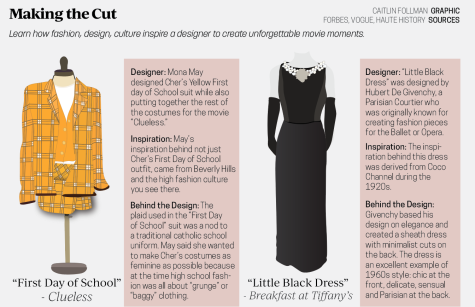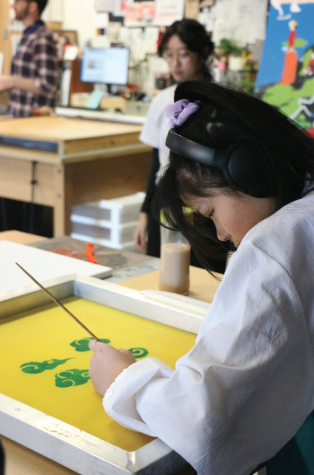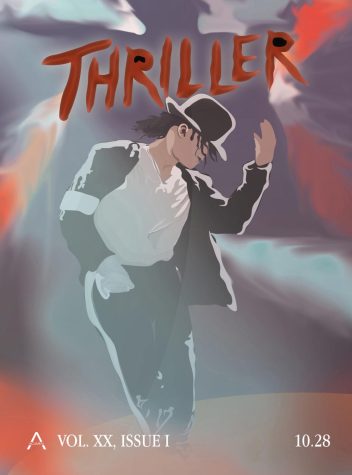Costume Couture
Tech theatre, fashion creators discuss value of costume design
Shuffling through an assortment of heels, skirts and wigs, tech theater students at this school organize outfits to bring the upcoming show to life. Olivia Sumner, tech theater student and senior, said these costumes can greatly affect performances and has first hand experience with their impact on audiences and students alike.
Good costuming can make or break a show, according to Sumner, and providing the right costumes at a good speed is an important part of performances here at CHS.
“The costume has to be on our side— prepared for (the performers) and perfect for them so they don’t stress out about it.” Sumner said. “I think it also helps them get into character, as it is an extension of the character in a sense.”
Celia Hamilton, fashion student and senior, said costumes and clothing allow for a wider range of self expression as well. Although Hamilton solely focuses on personal clothing design, she agrees that clothing and costumes alike can heighten personal expression.
Hamilton said that costume designing can lead to altered perception of characters.

American costume designer Deborah Nadoolman Landis explains in her book Dressed: A Century of Hollywood Costume Design that costume design goes beyond character superficiality.
“Ultimately, a costume must perfectly describe the individual for whom it was designed—not the superficial shell of a character but the outward expression of inner experience, the concrete manifestation of the character’s self-image,” Landis wrote.
When designing costumes, Darcie Stanisic, Fashion and Textiles teacher, said multiple factors can shape how characters are perceived. These factors include the color scheme of costumes to the personal traits of performers.
Because many of the costumes in CHS performances are created by students, these concepts are important for them to keep in mind.
Sumner said, “I think most of the time (costumes are) really good and people are really creative with how they can put together an outfit. One of my really good friends was the costume designer for all of last year and she did a really good job at putting together (clothes) and making sure the whole thing was organized so people got the right costumes.”
However, Sumner said, because the costumes are so vital to the perception of characters, directors always have the final say in the designs.
Adding to the idea of character perception, Stanisic commented on how fashion has affected the newer generations’ perception of costuming on a larger stage. She explained the perception of characters has become more rapid due to shorter attention spans, and costumes must fit the part to grab the viewer’s eye.
Stanisic also said costuming can lead to an unconscious judgment of character.
“Somebody might perceive (another person) in a certain way based on their style,” she said. “Mainly it depends on the generation…because (judgment occurs) faster now.”

Celia Hamilton, fashion student and senior, makes progress on a new art project for design printing. Hamilton said she is constantly taking on new projects, those which work to combine both art and fashion.
In costume design and perception of artists, actors and performers, this is an important idea to take into consideration. From a tech theater perspective, Sumner said costume design helps with how viewers perceive actors.
Sumner said, “I think our competition show this year, which was “Edward Tulane,” showed how costumes can help the audience know who the character is. It was a very small cast and the costumes helped show the age of the characters they were trying to play and differentiate between characters.”
Perception is especially prominent in period plays, or plays that focus heavily on a different time period.
“Let’s say you look at Hamilton—(there is good) historic clothing. I think it really does have an impact whether it is historically accurate or if it’s an adaptation or something. I think it really plays a role in the style and the motion as well as just the tone of entertainment,” Hamilton said.
Sumner agreed. “We’ve been doing a lot of period shows right now so we have to make sure the costumes are period (based), because if they’re not it will take away a lot of the environment of the show.”
“Last year the Accents had really really bright and neon dresses and I think it really helped their show a lot because it made it a lot brighter and just gave off a more positive vibe. With the Ambassadors they had more themes. So they had more of a 1920’s kind of outfit then that correlated with their songs. And then it changed into a New York kind of more street wear kind of thing. It illustrated the transition of time that happened.”
Although period pieces in particular require quality costume design, Sumner and Hamilton agree fashion is an important aspect of everyday life, performances, and personal appearance as a whole.
“(Fashion) is not just about how you look but also a way to express yourself,” Hamilton said. “It is about self expression so you get to know people through their personality and also through how they dress.”





